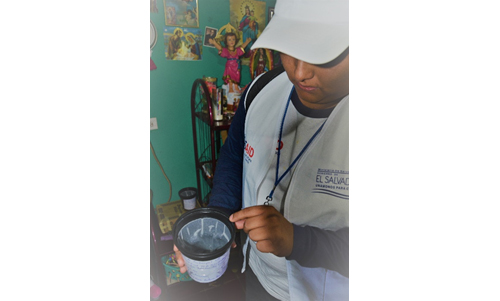Counting Mosquito Eggs with a Smartphone – Part 1: The Challenge
Part 1: THE CHALLENGE

A little over a year ago, we began to test the potential of using a smartphone to help count mosquito eggs we collect to track mosquito populations in areas of disease transmission. We knew we needed help when we saw the overwhelming labor needs during our field work while implementing the USAID-funded and Abt-led Zika AIRS project (ZAP). ZAP provided assistance to the countries of Central America and the Caribbean from 2016 to 2019 as part of an emergency response to fight Zika.
The research, analysis and subsequent proof-of-concept led to an Abt innovation called the Mosquito Egg Computer Vision (MECVision) prototype.
Why We Count Mosquito Eggs
It's hard to overstate the global burden that mosquito-borne diseases have on society. The contact between mosquitoes Aedes aegypti and humans facilitates the transmission of infectious diseases such as Zika, dengue fever and chikungunya.
To eliminate or reduce the spread of these diseases, we have to collect information about the mosquito populations involved in their transmission and determine their distribution, abundance and breeding habits, among other facts.
Just one of the ways that we gather data about mosquitoes in an environment is to track them at the last mile -- literally down to where individual mosquitoes lay their eggs. We track changes over time.

The Challenge of Counting
Local health workers or field technicians set traps (called ovitraps — in this case paper ovitraps) in standing water containers. The traps attract female mosquitoes that lay their eggs on the inner surfaces of the trap. The eggs then stick to the paper on the side. The technicians return to these individual sites a week later to collect the papers and count the eggs that are exposed on the paper.
Given the small size of mosquitoes themselves, you can just barely see the eggs with the naked eye. They look like tiny grains of ground coffee. While the typical mosquito can lay around 100-200 eggs at a time, you can have many hundreds of such “grains” on a given sheet of ovitrap paper, which is about the size of a standard napkin.
Finding a Better Way

As it turns out, counting mosquito eggs by hand is tedious, eye-straining, error-prone, inconsistent and time-consuming work. It’s one of those tasks that once you start doing it manually, your “there-has-to-be-another-way-to-do-this” voice kicks in.
When health workers are conducting surveillance of only a few ovitraps deployed in the field, the process of manually counting the eggs of each trap might be viable. However, when mosquito surveillance is a wide-scale initiative, and the number of houses under monitoring is a hundred or more, you need an enormous number of workers. Our team decided we needed a faster tool and developed it with the help of our technology-savvy colleagues at Abt.
Read part two of this blog: The Process for Designing an Automated Egg Counter
